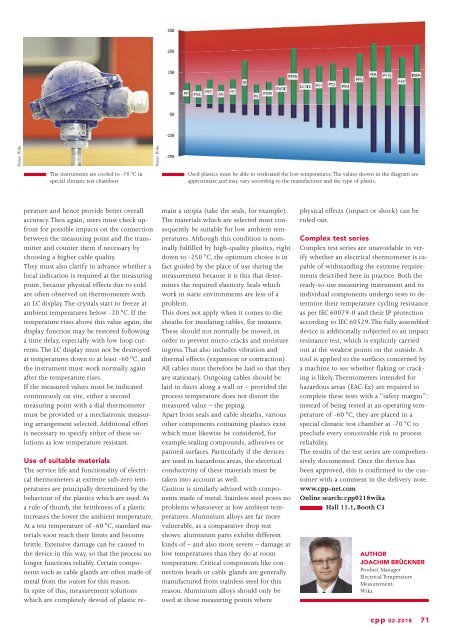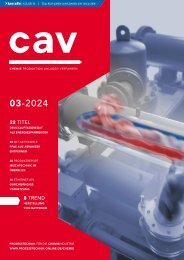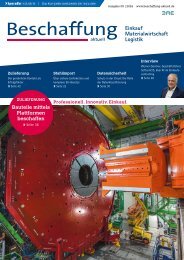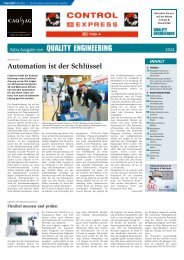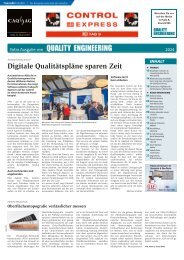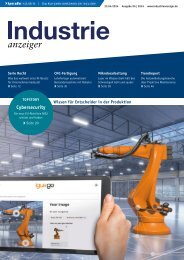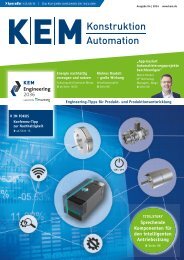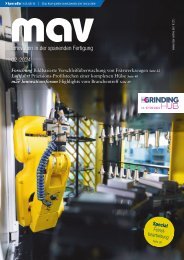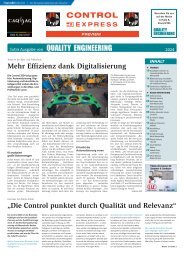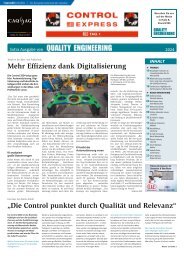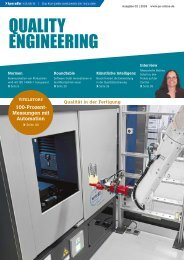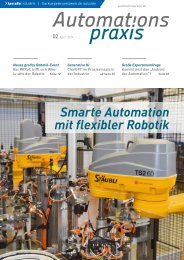cpp - Process technology for the chemical industry 02.2018
Create successful ePaper yourself
Turn your PDF publications into a flip-book with our unique Google optimized e-Paper software.
Picture: Wika<br />
Picture: Wika<br />
The instruments are cooled to -70 °C in<br />
special climatic test chambers<br />
Used plastics must be able to withstand <strong>the</strong> low temperatures. The values shown in <strong>the</strong> diagram are<br />
approximate and may vary according to <strong>the</strong> manufacturer and <strong>the</strong> type of plastic.<br />
perature and hence provide better overall<br />
accuracy. Then again, users must check upfront<br />
<strong>for</strong> possible impacts on <strong>the</strong> connection<br />
between <strong>the</strong> measuring point and <strong>the</strong> transmitter<br />
and counter <strong>the</strong>m if necessary by<br />
choosing a higher cable quality.<br />
They must also clarify in advance whe<strong>the</strong>r a<br />
local indication is required at <strong>the</strong> measuring<br />
point, because physical effects due to cold<br />
are often observed on <strong>the</strong>rmometers with<br />
an LC display. The crystals start to freeze at<br />
ambient temperatures below -20 °C. If <strong>the</strong><br />
temperature rises above this value again, <strong>the</strong><br />
display function may be restored following<br />
a time delay, especially with low loop currents.<br />
The LC display must not be destroyed<br />
at temperatures down to at least -60 °C, and<br />
<strong>the</strong> instrument must work normally again<br />
after <strong>the</strong> temperature rises.<br />
If <strong>the</strong> measured values must be indicated<br />
continuously on site, ei<strong>the</strong>r a second<br />
measuring point with a dial <strong>the</strong>rmometer<br />
must be provided or a mechatronic measuring<br />
arrangement selected. Additional ef<strong>for</strong>t<br />
is necessary to specify ei<strong>the</strong>r of <strong>the</strong>se so -<br />
lutions as low temperature resistant.<br />
Use of suitable materials<br />
The service life and functionality of electrical<br />
<strong>the</strong>rmometers at extreme sub-zero temperatures<br />
are principally determined by <strong>the</strong><br />
behaviour of <strong>the</strong> plastics which are used. As<br />
a rule of thumb, <strong>the</strong> brittleness of a plastic<br />
increases <strong>the</strong> lower <strong>the</strong> ambient temperature.<br />
At a test temperature of -60 °C, standard materials<br />
soon reach <strong>the</strong>ir limits and become<br />
brittle. Extensive damage can be caused to<br />
<strong>the</strong> device in this way, so that <strong>the</strong> process no<br />
longer functions reliably. Certain components<br />
such as cable glands are often made of<br />
metal from <strong>the</strong> outset <strong>for</strong> this reason.<br />
In spite of this, measurement solutions<br />
which are completely devoid of plastic remain<br />
a utopia (take <strong>the</strong> seals, <strong>for</strong> example).<br />
The materials which are selected must consequently<br />
be suitable <strong>for</strong> low ambient temperatures.<br />
Although this condition is nominally<br />
fulfilled by high-quality plastics, right<br />
down to -250 °C, <strong>the</strong> optimum choice is in<br />
fact guided by <strong>the</strong> place of use during <strong>the</strong><br />
measurement because it is this that determines<br />
<strong>the</strong> required elasticity. Seals which<br />
work in static environments are less of a<br />
problem.<br />
This does not apply when it comes to <strong>the</strong><br />
sheaths <strong>for</strong> insulating cables, <strong>for</strong> instance.<br />
These should not normally be moved, in<br />
order to prevent micro-cracks and moisture<br />
ingress. That also includes vibration and<br />
<strong>the</strong>rmal effects (expansion or contraction).<br />
All cables must <strong>the</strong>re<strong>for</strong>e be laid so that <strong>the</strong>y<br />
are stationary. Outgoing cables should be<br />
laid in ducts along a wall or – provided <strong>the</strong><br />
process temperature does not distort <strong>the</strong><br />
measured value – <strong>the</strong> piping.<br />
Apart from seals and cable sheaths, various<br />
o<strong>the</strong>r components containing plastics exist<br />
which must likewise be considered, <strong>for</strong><br />
example sealing compounds, adhesives or<br />
painted surfaces. Particularly if <strong>the</strong> devices<br />
are used in hazardous areas, <strong>the</strong> electrical<br />
conductivity of <strong>the</strong>se materials must be<br />
taken into account as well.<br />
Caution is similarly advised with components<br />
made of metal. Stainless steel poses no<br />
problems whatsoever at low ambient temperatures.<br />
Aluminium alloys are far more<br />
vulnerable, as a comparative drop test<br />
shows: aluminium parts exhibit different<br />
kinds of – and also more severe – damage at<br />
low temperatures than <strong>the</strong>y do at room<br />
temperature. Critical components like connection<br />
heads or cable glands are generally<br />
manufactured from stainless steel <strong>for</strong> this<br />
reason. Aluminium alloys should only be<br />
used at those measuring points where<br />
physical effects (impact or shock) can be<br />
ruled out.<br />
Complex test series<br />
Complex test series are unavoidable to verify<br />
whe<strong>the</strong>r an electrical <strong>the</strong>rmometer is capable<br />
of withstanding <strong>the</strong> extreme requirements<br />
described here in practice. Both <strong>the</strong><br />
ready-to-use measuring instrument and its<br />
individual components undergo tests to determine<br />
<strong>the</strong>ir temperature cycling resistance<br />
as per IEC 60079-0 and <strong>the</strong>ir IP protection<br />
according to IEC 60529. The fully assembled<br />
device is additionally subjected to an impact<br />
resistance test, which is explicitly carried<br />
out at <strong>the</strong> weakest points on <strong>the</strong> outside. A<br />
tool is applied to <strong>the</strong> surfaces concerned by<br />
a machine to see whe<strong>the</strong>r flaking or cracking<br />
is likely. Thermometers intended <strong>for</strong><br />
hazardous areas (EAC-Ex) are required to<br />
complete <strong>the</strong>se tests with a “safety margin”:<br />
instead of being tested at an operating temperature<br />
of -60 °C, <strong>the</strong>y are placed in a<br />
special climatic test chamber at -70 °C to<br />
preclude every conceivable risk to process<br />
reliability.<br />
The results of <strong>the</strong> test series are comprehensively<br />
documented. Once <strong>the</strong> device has<br />
been approved, this is confirmed to <strong>the</strong> customer<br />
with a comment in <strong>the</strong> delivery note.<br />
www.<strong>cpp</strong>-net.com<br />
Online search: <strong>cpp</strong>0218wika<br />
Hall 11.1, Booth C3<br />
AUTHOR:<br />
JOACHIM BRÜCKNER<br />
Product Manager<br />
Electrical Temperature<br />
Measurement,<br />
Wika<br />
<strong>cpp</strong> 02-2018 71


